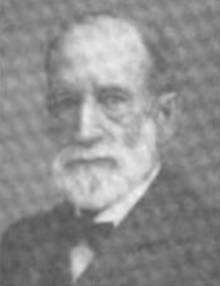George Edward Post
George Edward Post (1838–1909) was an American surgeon and academic.
George Edward Post | |
|---|---|
 | |
| Born | December 17, 1838 New York, New York |
| Died | September 30, 1909 (aged 70) Beirut, Syria |
| Education | University College of New York |
| Parent(s) |
|
| Awards | Order of the Red Eagle |
Biography
George Edward Post was born in New York City on December 17, 1838, the son of Alfred Charles Post.[1][2]
He was a professor of surgery at the Syrian Protestant College in Beirut, now the American University of Beirut (AUB).[3] He had originally graduated from University College of New York.[4] He later published 18 articles in Arabic, including Arabic Dictionary of the Holy Bible, Classification and Study of Principles of Plant Physiology and Function and Rules How to Succeed and converted 2 text from Arabic into English.[4] Post published broadly in the areas of natural history, medicine, and theology.[5] Post formally described 221 taxa, and published an extensive volume on the Plant of Syria, Palestine and Sinai in 1896. He was also one of the contributors to Smith's Bible Dictionary, in 1893.[6] He was also the editor (with John Edward Dinsmore), published in 1932 of Flora of Syria, Palestine, And Sinai: Volume 1: A Handbook of The Flowering Plants and Ferns, Native and Naturalized From The Taurus to Ras Muhammad And From the Mediterranean Sea to The Syrian Desert, Vol I and II,[7] which includes description of many new plants including Iris hermona.[8]
For his work as a surgeon and missionary, he received the Order of the Red Eagle from the Kingdom of Prussia.[2]
He died in Beirut on September 30, 1909.[2]
References
- Herringshaw, Thomas William, ed. (1914). Herringshaw's National Library of American Biography. IV. American Publishers Association. p. 493. Retrieved July 23, 2020 – via Google Books.
- "George Edward Post Dead". The Sun. October 1, 1909. p. 6. Retrieved July 23, 2020 – via Newspapers.com.
-

- Mounir(Munir) E Nassar, M.D., FACP Clinical Medicine Research History at the American University of Beirut, Faculty of Medicine (120-1974), p. 6, at Google Books
- L.J. Musselman and N.S. Saoud, 2004. The Type Specimens of George Edward Post in Beirut and Geneva Archived 2017-08-14 at the Wayback Machine. Turkish Journal of Botany, 28, 155-160.
- Robert E. Thompson A History of the Presbyterian Churches in the United States, p. 21, at Google Books
- "Flora of Syria, Palestine, And Sinai". abebooks.com. Retrieved October 31, 2016.
- "Iridaceae Iris hermona Dinsm". ipni.org (International Plant Names Index). Retrieved October 24, 2016.
- IPNI. Post.
Other sources
- Jessup, H. H., 1910. Fifty-three years in Syria. New York: Fleming H. Revell. 2 volumes.
- Khoury, G.Y., 1992. The founding fathers of the American University of Beirut biographies. Beirut: American University of Beirut. Pp 232 (English), 215 (Arabic).
- Musselman, L.J., 2006. The botanical activities of George Edward Post (1838-1909). Archives of Natural History 33(2): 282-301.